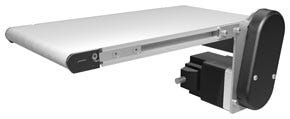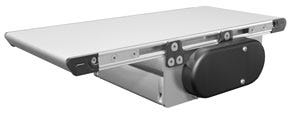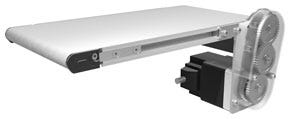How do you move something that’s minuscule? It's a question medical device manufacturers have wrestled with for years. Making miniature devices, such as catheters or stents, or componenets isn’t the problem. Rather, it’s properly moving them from one process to the next that’s remained challenging.New advances in conveying systems can better address the handling of small parts. These advances eliminate various problems faced by designers and engineers.
April 12, 2013
Old-School Handling
|
A miniature conveyor belt can be used in small spaces. |
It’s safe to say that manufacturing machines and equipment are not designed around a conveyor system. Conveyors are often an afterthought in the design process. The functionality of the machine almost always takes precedence, while add-on accessories such as the conveyor system come later. When it does come time to think about conveyors, decisions about what to specify, build or purchase, and install are frequently made at the last minute—and that’s a problem.
This backward approach to conveyors often results in poor performance and negatively affects productivity. Consider the following example. A company is planning to ramp up production, and a conveyor is needed to move small finished parts from a machine to a vision inspection station. Because the space is tight and no conveyor system is readily available to service the application, the decision is made to build one in-house. An engineer is tasked with building the conveyor from scratch to get the line up and running.
This plan of attack is likely destined to have problems for a number of reasons. For starters, the task is taking an engineer away from his core competencies and asking him to build a conveyor. That’s not the engineer's job, and he doesn’t have the expertise to properly build one. If a company manufactures vials, why would it waste its time building conveyors? And once the conveyor is it built, what will the company do about spare parts? Who is the company going to call if the conveyor does not run properly? What happens if the person who built it is on vacation or no longer works for the company? Then who’s in charge of maintaining the conveyor? These are just some of the questions that illustrate why conveyors built in-house aren’t such a good idea.
But building conveyors in-house is exactly what many device firms have done for years, mainly because there were few commercially built conveyors designed specifically for the medical industry and that were small enough to fit the applications. That’s beginning to change as new technologies and automation are making strides to enhance the form, fit, and function of conveyor systems. The technologies can relegate old in-house units into retirement.
|
A miniature conveyor belt with a pinch drive features a low profile. |
|
This miniature conveyor features a ghosted gear box. |
No Viable Option
A long-time problem with conveyors serving the medical industry has been their size. The components being produced are small and lightweight, and many of the spaces where conveyor systems need to be positioned within a machine for in-feed and out-feed service are extremely tight. Tight spaces require small conveyors, but there haven’t been many viable options available to companies. North American conveyor manufacturers have traditionally shied away from this market for a variety of reasons, mainly due to the amount of research and development required to make a suitable product offering for this market. When it comes to design, conveyor manufacturers historically overdesign their products to help increase performance (e.g., bigger bearings, more robust frame). Going small is something new, and many traditional conveyor firms likely have not wanted to invest the time and effort for this market.
Conveyors typically fall into four duty classes.
In-Feed and Out-Feed. These types of conveyors either move components to a machine for processing or take parts that are in process of finished, or scrap material, out of a machine for additional processing or disposal.
Move Through or Within. This type of conveyor runs through or is located within a machine and is used in applications to move components from one process to another within the machine structure.
Bridge Between. These types of conveyors link machines together and move the components from one machine to the next for processing.
Main Artery. This type of conveyor serves as the main artery for moving components through the primary processing line. Much like an assembly line, the main artery conveyor will have several machines and processing activity interacting with components as it moves down the line.
The in-feed and out-feed and move-through or within applications are ideal for smaller-fitting conveyors due to the small, lightweight parts they move and their locations within machines. The bridge-between and main-artery applications involve larger conveyors.
Small Part Challenges
The handling of medical products has unique and very stringent requirements. Their small, lightweight, and fragile design can make them difficult to handle, orient, and move on a conveyor from one processing area to the next. When designing a conveyor system to best work within an application, engineers face several challenges to consider in moving, orienting, and transfering of parts.
Part End Transfer. Since the parts are so small, the ability to transfer them from one conveyor to the next can be problematic. Parts are often less than 1 in. in size and therefore require a roller diameter much less than 1 in. Typical conveyors have rollers that are 1¼ in. or larger, a size that is simply too large to be practical as a viable transfer mechanism. Small parts attempting to transfer over a 1¼-in. or larger roller could fall between the two adjoining rollers of the conveyors and become damaged. Another transfer option can be the waterfall transfer, which is accomplished by placing the roller of one conveyor over the next and letting parts fall onto the lower conveyor. While this option solves the transfer issue with the larger rollers, it does not maintain product orientation, and parts can become damaged due to the fall.
Part Side Transfer. If a part cannot be transferred off the end of a conveyor, the alternative method is to transfer it off the side to an adjoining parallel conveyor. The problem with this type of transfer is that bearing housings typically are on the outside of the conveyor, preventing a flush meeting between the top conveyors. This causes a gap, which very small parts can fall through.
Conveyor Belt Flatness. Typical operations performed in medical applications include vision inspection, filling, and robotic pickup, all of which require that the part be flat on the conveyor belt. Because the part itself is so lightweight, it cannot force the conveyor belt flat and thus will simply follow the surface flatness of the belt. Belting used for small end rollers needs to be very thin, and these thin belts have a tendency to curl when placed under tension, much like what happens to a rubber band when it is stretched out. This belt curl prevents the light part from lying flat, thereby causing problems for the automation process.
Size of the Conveyor. The floor space an engineer is given for an assembly machine is relative to the product being assembled. If the parts manufactured are small, the room likely won’t be very large. There is simply no space in the machine for oversized conveyors and the associated motors and drives that go with them. Further, because the machine isn’t big, the distance between operations is short. Therefore, the conveyor transporting the product from one operation to the next is short, often less than 12 in. long. As discussed, manufacturers typically don’t build small conveyors and do not offer conveyors this short because the room required for end rollers doesn’t allow it.
The Pinch Drive
Designing a conveyor system to move and handle tiny medical device parts can be problematic. Some of the design challenges to overcome include reduced bearing life due to small bearings, small component strength and durability, consistent short belt fabrication, and effective use of product space. Additionally, conveyor manufacturers need to take into account the handling and orientation of parts during movement, as well as the overall environment they’re operating in.
To build a miniature conveyor, end rollers have been reduced to 5/8 in. This profile enables them to fit into tight spaces within a machine. When positioned together end-to-end, they can also successfully transfer products as small as 7/8 in. in diameter. The bearing housings are fully encapsulated within the conveyor frame. The advantage is that two conveyors can be positioned side-by-side and be nearly flush with one another with only a 1/4-in. gap from belt edge to belt edge.
Another challenge in building a miniature conveyor with a low profile is developing a mechanism to drive the belt. The mechanism that may work best is a pinch drive, a new engineering option that allows the conveyor to run with almost no belt tension. Typical belt conveyors run under high tension, which is needed to give the drive roller enough traction to drive the belt. However, this tension causes bearings and conveyor rollers to be oversized—something that wouldn’t be feasible in a miniature conveyor.
The pinch drive forces the conveyor belt against the drive roller, giving it driving traction without the use of tension. Conveyors have two pinch drive mechanisms, each spring loaded against the drive roller. This design allows the belt to be run in either direction and only requires enough belt tension to lay the conveyor belt flat. Since overtensioning the belt is not required, the belt lays flatter, which is necessary for lightweight components.
Conclusion
Miniature conveyors give engineers more options in designing their applications, such as allowing them to integrate the right-sized conveyor into their machine. Space is tight, and anytime an engineer can fully maximize a given space, the more efficiently the application will operate. Miniature conveyors also address product handling issues by expanding the available options to position and orientate parts as the move through production. The bottom line is that miniature conveyors provide added flexibility to design engineers in handling small parts for medical device and pharmaceutical applications.
 Mike Hosch is the director of engineering at Dorner Mfg. Corp. Since 1985, Hosch has held many titles at Dorner, including mechanical engineer, chief engineer, and manager of new product development. Hosch has a bachelor’s degree in mechanical engineering from the Milwaukee School of Engineering. He holds multiple patents in conveyor design and is a licensed engineer in the state of Wisconsin. He can be reached at [email protected].
Mike Hosch is the director of engineering at Dorner Mfg. Corp. Since 1985, Hosch has held many titles at Dorner, including mechanical engineer, chief engineer, and manager of new product development. Hosch has a bachelor’s degree in mechanical engineering from the Milwaukee School of Engineering. He holds multiple patents in conveyor design and is a licensed engineer in the state of Wisconsin. He can be reached at [email protected].
Related Stories
Reduce Medical Device Costs the Automotive Way
Meet Baxter, A Robot That Wants You to Rethink Manufacturing
You May Also Like





